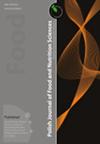Characterization of Triterpene Saponin Composition of White, Yellow and Red Beetroot (Beta vulgaris L.)
IF 2.3
4区 农林科学
Q3 FOOD SCIENCE & TECHNOLOGY
引用次数: 3
Abstract
– group of – have spurred a growing due to their health-promoting properties. This study aimed to gain information on triterpene saponin profile of the peel and flesh of white, yellow and red beet of six cultivars – Snow Ball, Boldor, Ceryl, Chrobry, Forono and Tytus – harvested in Poland, in the same region. Twenty four saponins with oleanolic acid, hederagenin, akebonoic acid and gypsogenin as aglycons were identified and quantified by liquid chromatography/tandem mass spectrometry (LC--ESI-MS/MS). Among them, betavulgaroside I, II, III and IV were the major compounds, but the quantitative profile of saponins was found to be de- pendent on beet cultivar and root part, respectively. The highest content of saponins was found in the peel of yellow B. vulgaris Boldor (20812 mg/kg fresh weight, fw), while the lowest saponin content was determined in the flesh of white B. vulgaris Snow Ball (497 mg/kg fw). In addition, the total saponin content in peel and flesh in yellow beet (26054 mg/kg fw) was much higher than the total content in peel and flesh in red beet Tytus (8364 mg/kg fw) and white beet Snow Ball (1204 mg/kg fw). This is the first report on the profile of saponins in white and yellow beets.白、黄、红甜菜根(Beta vulgaris L.)三萜皂苷成分的表征
由于具有促进健康的特性,这类食品的需求量越来越大。本研究旨在获得在波兰同一地区收获的6个品种(Snow Ball、Boldor、Ceryl、Chrobry、Forono和Tytus)的白、黄、红甜菜的果皮和果肉的三萜皂素谱信息。采用液相色谱-质谱联用技术(LC- ESI-MS/MS)对齐墩果酸、异黄酮苷元、木犀草酸和石膏皂苷元等24种皂苷进行了鉴定和定量。其中甜菜皂苷I、II、III和IV是主要成分,但各皂苷的定量分布分别与甜菜品种和甜菜根部位有关。黄皮中皂苷含量最高(20812 mg/kg鲜重,fw),白皮中皂苷含量最低(497 mg/kg fw)。此外,黄甜菜的皮和肉总皂苷含量(26054 mg/kg fw)远高于红甜菜的皮和肉总皂苷含量(8364 mg/kg fw)和白甜菜的雪球(1204 mg/kg fw)。这是关于白甜菜和黄甜菜中皂苷含量的首次报道。
本文章由计算机程序翻译,如有差异,请以英文原文为准。
求助全文
约1分钟内获得全文
求助全文
来源期刊

Polish Journal of Food and Nutrition Sciences
FOOD SCIENCE & TECHNOLOGY-
CiteScore
4.30
自引率
12.50%
发文量
25
审稿时长
20 weeks
期刊介绍:
The Polish Journal of Food and Nutrition Sciences publishes original, basic and applied papers, reviews and short communications on fundamental and applied food research in the following Sections:
-Food Technology:
Innovative technology of food development including biotechnological and microbiological aspects
Effects of processing on food composition and nutritional value
-Food Chemistry:
Bioactive constituents of foods
Chemistry relating to major and minor components of food
Analytical methods
-Food Quality and Functionality:
Sensory methodologies
Functional properties of food
Food physics
Quality, storage and safety of food
-Nutritional Research Section:
Nutritional studies relating to major and minor components of food (excluding works related to questionnaire
surveys)
-“News” section:
Announcements of congresses
Miscellanea
 求助内容:
求助内容: 应助结果提醒方式:
应助结果提醒方式:


